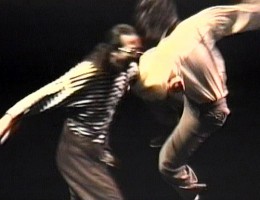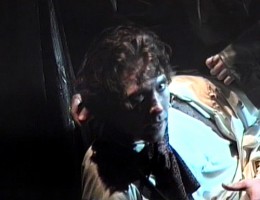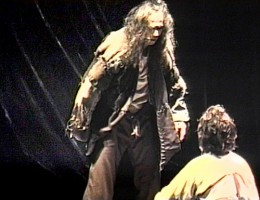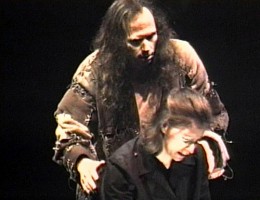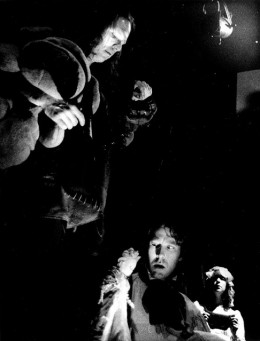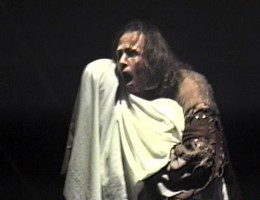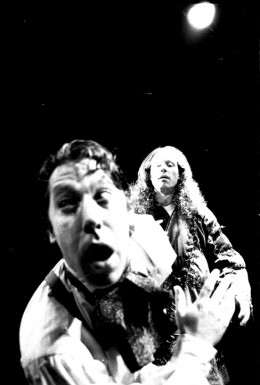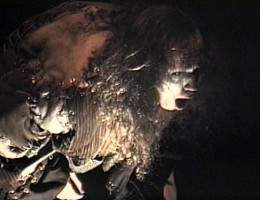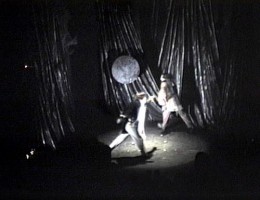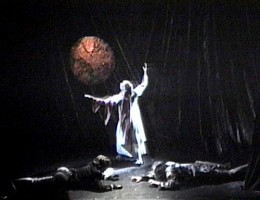A revisioning, for a trio of clowns, of the Mary Shelley epic about our culture’s denial of death.
Directed & designed by Conrad Bishop, music by Elizabeth Fuller
Lights by Craig Young
Costumes by Erica Holscher
Creative consultants: Joan Schirle, Eric Schoefer
Two acts; 2m/1w, multi-character; unit set.
Written by Conrad Bishop & Elizabeth Fuller, based on the novel by Mary Shelley and based on workshops with Touchstone Theatre and the Eye’s Genesis Ensemble. Co-produced by Touchstone Theatre and The Independent Eye, premiering April 1, 1998, at Old City Stage Works (Philadelphia, PA) and April 22, 1998, at Touchstone Theatre (Bethlehem, PA). Toured to Mad River Theatre Festival (Blue Lake, CA). High school version toured Philadelphia schools in February, 1998. Total of 40 performances.
It’s all things to all people. A prototype of the sci-fi genre. An object of parody. A cautionary tale about technology. A myth of mankind’s betrayal by its Creator. For us personally, The Living Theatre’s expressionistic Frankenstein in 1969 showed us the power of ensemble-based theatre and changed the way we chose to lead our lives.
For us, the story can’t be divorced from the utopian visions that permeated Mary Shelley’s environment. Daughter of Mary Wollstoncroft and William Godwin, notorious philosophers of human rights, and wife of Percy Shelley, whose radicalism got him kicked out of Oxford and disowned by his father, Mary Shelley was 19 (and had suffered miscarriages and loss of an infant) when the anonymously published Frankenstein became a sensation.
For Shelley, monsters are made, not born. Nothing in the novel suggests that the Creature is inherently evil; there’s no clear image of what makes him repellent. So why does Victor reject his handiwork? Why do fathers abandon their children? Why do we write off vast numbers of our fellows as human garbage? Why, in a consumers’ paradise, do we seem to live in a world not of abundance but of scarcity?
Shelley wrote her story in difficult times, in the company of friends. In these times, we’ve been privileged to retell her story with the enormous assistance of friends. More than 15 Philadelphia actors and artists contributed to its improvisational exploration, playing—for example—about 20 different versions of the animation scene. Our consulting directors, our class at Penn, the trio of our high school pilot tour all added their talents. And finally, of course, the Touchstone trio.
Out of this process, we could have created many different Frankensteins. For better or worse, this is the one we chose. The best response we could wish is to induce you to think about how you would tell the tale, what resonances in your own life are struck by Victor, by Elizabeth, by the Creature. We tell this tragic story not because we want you to believe in its inevitability but because we’d like to see it change.
—Mark Cofta, Main Line TimesWe all know the story of Frankenstein, but no version has revealed the feelings of all the major characters with such sensitivity. . . . This Frankenstein successfully counteracts the popular mythology that has flattened Shelley’s serious themes and insights, which are still relevant nearly 200 years later.
—Barry Black, The Times-StandardThis prime example of innovative, physical theater aims higher than the others. It dares more. It stays on the pink scar between well whacked out comedy and deeply felt tragedy. The 90 minute play never backs off. . . . Of all the Frankensteins you’ve seen, you haven’t seen one like this. It creates dread. And it does it, in part, by being daffy. An unexpected bonus: the high-schoolers—a most finicky crowd—in the audience the other night loved it. “It was so sweet,†said one. “I laughed till my neck hurt.â€
—The Philadelphia WeeklyThe Independent Eye’s adaptation does not allow easy definition. It sails between episodes from the book—the final confrontation on the iceberg in the Arctic seas—and scenes remembered from film versions. Interspersed are moments of pure imagination, many danced or mimed, that color and shape a wholly original, sometimes absurdist vision of the story and its spinoffs. Some are intentionally clownish, others consciously poetic. All carry the audience along into the undercurrent of the presentation, the need to connect, to know love. . . . More than anything, The Independent Eye has looked at what has become a hackneyed story and made it new and original; it’s fun that catches you up short with its seriousness.

